|
 |
The Memotech MTX Series |
 |
Memotech Multi-Function Expansion System
MFX Support
SD Card Compatibility
MFXs with serial numbers up to 18 were
shipped with ROM versions that did not support partitioned media
and were supplied with either a 512MB or 1GB micro SD card (of
which 240MB or 754MB was wasted space). No problems were
detected during testing and none have been reported since
delivery.
Versions of the MFX ROM dated 14/01/2024
and later support SD cards partitioned partitioned in the PC
sense, i.e., the CP/M "partitions" (disk images) and HEXTRAIN
data file are saved to an area of the card with a Partition
ID of 52 (CP/M). The remainder of the card can he configured
as a FAT32 partition for use with a PC. Bill added this
functionality and wrote a CP/M utility (fatcopy.com)
that allows MFX to transfer files between the CP/M "disks" and
the FAT partition. (This enhancement allows MFX to make
optimum use of larger SD and SDHC cards, SDXC cards continue to
be incompatible
with MFX.) As small SD cards are becoming harder to find and
more expensive, the majority of more recent shipments of MFX
have been with larger, 4GB, cards.
The small number of SD cards that I have
left over from the batches used for the initial shipments of MFX
have been found to work well with partitioned media, but perhaps
I just got lucky with the original supply.
Results with larger and more modern SD
cards have been mixed. The situation is complicated by
the fact that you cannot always tell exactly what flavour of
card that you are buying when shopping on the likes of eBay and
Amazon, cards advertised as being from a particular manufacturer are
often fake!
When setting up new SD cards in this
manner, I found that not all SD cards work well in this scenario
and could exhibit a number of problems, such as not being
bootable by MFX or having intermittent write problems. We have
not been able to get to the bottom of why this might be, but it
could be related to the access mode that MFX uses and the card's
compatibility with it.
The SD specification advises that SD
cards can be accessed in three modes, 1 bit SD mode, 4 bit SD
mode and SPI mode. In order to use the SD modes in a design, a
paid license is needed from the SD
Association, SPI mode does not require a license,
therefore, MFX uses SPI mode to access the SD card. It
has been found that older cards support all of these modes, but
newer cards may not support SPI or implement it in a
non-standard manner and that older cards may perform better with
MFX than newer ones.
If you experience problems with
configuring a new SD card for MFX you might want to source a
cheap, say Class 4 or Class 6, SD/SDHC card and try again. It
seems that these issues are not unique to MFX, you can read
about similar issues seen by Ralf Thelen (lisy.dev)
on his page
here. Martin and Bill have not seen many problems, but I
have been buying quite a lot more cards from a number of
different vendors and started to see more frequent issues with
the cards that I was buying.
The failures that I have seen with a number of different
SD cards are noted below, as with most things, YMMV!
Also note that one of my laptops provides
more information when ejecting an SD card than others, usually
giving the name of the manufacturer, or at least, the
manufacturer's name that corresponds to the code
that has been entered in the manufacturer field, which, in the case of
many of the Chinese knock-offs, is not always accurate.
It is clear from the table below that
finding suitable SD cards for use with MFX is not as easy as it
should be. It is difficult to believe that so many of the cards
that I have tried are failing to meet SD standards and I am
starting to think that the SD code in MFX may have an inherent
flaw that limits its use to a very small subset of SD/TF cards.
This potential issue warrants further investigation, though this
may not be easy as I was able to return most of the failing
cards to the sellers for refunds.
|
Description |
Front |
Back |
Unbranded
Generic 1 GB TF Card from AliExpress (purchased 06/22)
The first batch of cards that I bough to ship with
MFX with the early versions of the ROM. Came without
adapters. Labeled as being from Taiwan.
R/W
speeds somewhere between Class 6 and 10
Worked
flawlessly and when tested with the later firmware, had
no issues with partitioning or booting MFX. (Likely to
be SD, rather than SDHC.) |
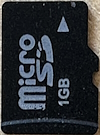 |
 |
Unbranded
Generic 512MB TF Card from AliExpress (purchased 07/22)
Again, bought to ship with the early versions of the
ROM. Came without adapters and also labeled as being
from Taiwan
R/W speeds consistent with Class 6
Worked flawlessly and when tested with the later
firmware, had no issues with partitioning or booting
MFX. (Likely to be SD, rather than SDHC.) |
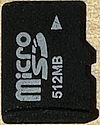 |
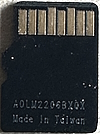 |
"Kingston Canvas Select" - Not!
Purchased from eBay UK, 01/24.
When partitioned,
fails to boot MFX.
Identified as "Toshiba" under
Windows 10
Capacity verified with
h2testw but with slow
W/R speeds, not Class 10
Advertised as "brand new and
genuine Kingston from an authorized reseller."
Poor quality packaging and printing, no unique serial
number label.
Confirmed by Kingston to be
counterfeit. Kingston also advised that their SDHC cards have been discontinued
and have not been manufactured by them for over 7 years. |
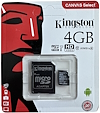 |
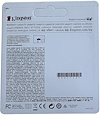 |
 |
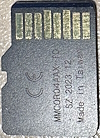 |
"Mitos" Generic 4GB TF cards, available from
many AliExpress sellers
I bought a trial batch of
5 from AE and tested them with h2testw.
The capacity verified OK and the R/W speeds were
consistent with Class
10. I thought that they would be fine for MFX, but when
I actually tried them some time later, I found that when
partitioned, they would not boot MFX.
Interestingly,
they were identified as "Toshiba APPSD" under Windows
10.
Even more interestingly, having wrongly
assumed that these cards would be ideal for MFX, I
purchased another 10 from the same seller. However, this
time they worked flawlessly, although they had identical
branding, they were identified as "Micron EITSD" under
Windows 10.
The cards were subtly different, the
"bad" cards were marked "23K" and the "good" cards were
marked "23L" (a later batch perhaps?). The good cards
had what appeared to be a date code of 231209 (yymmdd?) on the
reverse, but as they were ordered on 231213, that
doesn't seem likely, though it's possible I guess (or
the date code was yyddmm). The
bad card had a code of 231028 on it, if it is a date,
then being earlier than the 23L version does make sense.
The most obvious difference is that the good cards were
labeled "Taiwan" and the bad ones "China".
I bought third batch of cards from a different
seller which again were identified by Windows 10 as
"Toshiba APPSD" marked "24C". I was pleasantly surprised
when the card booted MFX, but writing was unreliable.
These cards were labeled "Taiwan" but had a
totally different set of printed text on the reverse,
had no CE label (not that that means anything on many
Chinese manufactured items) and did not perform as
well as the "23L" version.
|
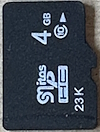 |
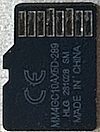 |
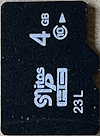 |
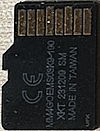 |
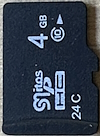 |
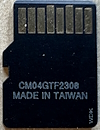 |
"Elite
Pro" Full Size 4GB SD Cards (AliExpress)
(purchased 02/24)
Appeared to be reasonable quality and worked fine
under Windows.
When partitioned,
fail to boot MFX.
|
 |
(blank) |
"Cloudisk"
Full Size 4GB SD Cards (AliExpress) (purchased 04/24)
Identified by
Windows 10 as "Generic SD Card"
When
partitioned, boots MFX but HEXTRAIN data is unreadable |
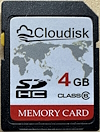 |
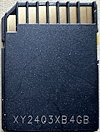 |
"Stickdrive"
4GB TF Cards (Aliexpress) (purchased 04/24)
Identified by Windows 10 as "Micron EITSD"
Works well when partitioned for MFX |
 |
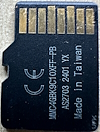 |
"Silicon
Power" 16GB SDHC TF Card (Amazon)
Martin
bought a couple of these off Amazon. Pretty nondescript
branding, no issues with MFX, R/W speeds consistent with
Class 10. |
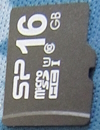 |
(blank) |
A
selection of Martin's cards :-
"INDMEM"
Full Size 2GB "SD" Card (origin unknown)
Turned
out to be SDHC
Initially worked fine with MFX
and was used for much of the firmware testing.
Laterly has started to shown signs of ware with
increacing write errors. |
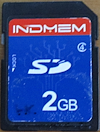 |
(blank) |
"Transcend" Full
Size 4GB SDHC Card (origin Amazon, vendor unknown)
Martin's current test card for MFX firmware
development,
Works well with no errors (so far!) |
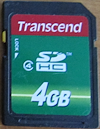 |
(blank) |
"GIGASTONE"
Full Size SDHC Card (origin Amazon, vendor unknown)
Initially worked fine with MFX
More recently
has started to show errors, although it has had much
less use than Martin's 2GB card. |
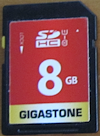 |
(blank) |
| |
|
|
Please let me know if you try
other cards with MFX and how it works out for you and I will
update the table accordingly.
SD Card Longevity
The majority of MFX users will likely use
the "disk" (SD card) to store files that are only ever likely to
be read, e.g., games files, but it is probably worth mentioning
an inherent issue with the use of
flash based
media, and that is the expected lifespan of the media.
Flash media has a finite lifespan before
issues can be expected to ocurr, i.e., the memory used has a
finite number of times that it can be written to (program–erase
cycles) before failures can be expected to start to ocurr.
Modern, good quality, media may have an expected cycle count of
anywhere between 10,000 and 100,000, or more. Older and low
quality media from, say, China, may have considerably less and
in any event, the technical specs are unlikely to mention it.
However, things aren't as bad as the
above might suggest, most (all?) SD cards, at least the good
quality ones, use techniques such that these memory issues are
"mitigated in some chip firmware" ... by counting the writes and
dynamically remapping blocks in order to spread write operations
between sectors; this technique is called wear
leveling. Another approach is to perform write verification
and remapping to spare sectors in case of write failure, a
technique called bad
block management (BBM)."
Most users are unlikely to ever see a
problem, but it is somethng that Martin has expeienced during
testing of the firmware, where the media has been subjected to
many formatting/write/erase cycles.
As with most computer issues,
the mitigation is to backup your media!
|